Alcaraz X Sinner. Wimbledon Final Preview
grass canvas sluggers — pump fakes — bullet train forehands — intangibles TM — serving — prediction
Five weeks after their epic Roland Garros final Carlos Alcaraz and Jannik Sinner will duel once again, this time for the Wimbledon crown. Alcaraz leads the H2H 8-4, winning the last five encounters, and is the two-time defending champion at SW19.
There’s no secrets between these two. In boxing parlance this is a fight between a slugger and a boxer-puncher. Sinner wants to control the middle baseline, take it hard and early, and suffocate you with jabs that land like hooks. In contrast, Alcaraz wants to use the whole grass canvas — both positionally and shot-wise — to weave deception, feel, and spin, into a game that has slugger power when given time.
I liked a line from Gill Gross recently where he said “you need a weakness to have a tactic” ( I don’t know which episode, sorry GG) and in terms of baseline play, this is such a fun match because the weaknesses are so small with these two. Their backhands are capable of changing direction on a whim. Alcaraz’s is more compact and better at taking returns hard and early. He’s used that to good effect in this rivalry before to apply pressure on Sinner’s second serve. Sinner’s is the heaviest on tour, using a huge dynamic flip to slingshot the ball at speeds comparable to more mortal tour forehands.
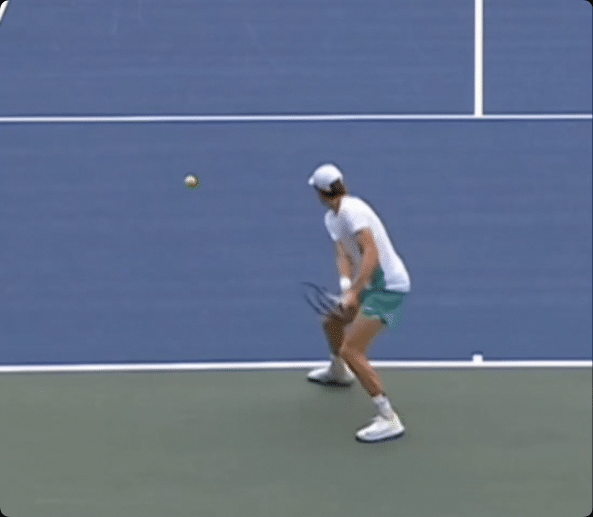

But I think it is the forehands that will be most pivotal in this match. Sinner and Alcaraz both have huge power off that wing. Sinner’s is lower and more compact, using a large dynamic flip from the outside to create speed. Alcaraz’s is more Federer 2005, with that scorpion-coiled setup pointing the racquet tip at this opponent before unwinding.
From a side angle you can see how linear Sinner’s forehand is: the hand and racquet head are at ball level much earlier, whereas Alcaraz uses more gravity to build power.
Tactically speaking, Alcaraz uses more height and spin to open angles and find uncomfortable contact heights in his opponents. Here’s an example against Fritz where he plays the first forehand much shorter and heavier to break the sideline, and then does the same on the follow up to the other wing:
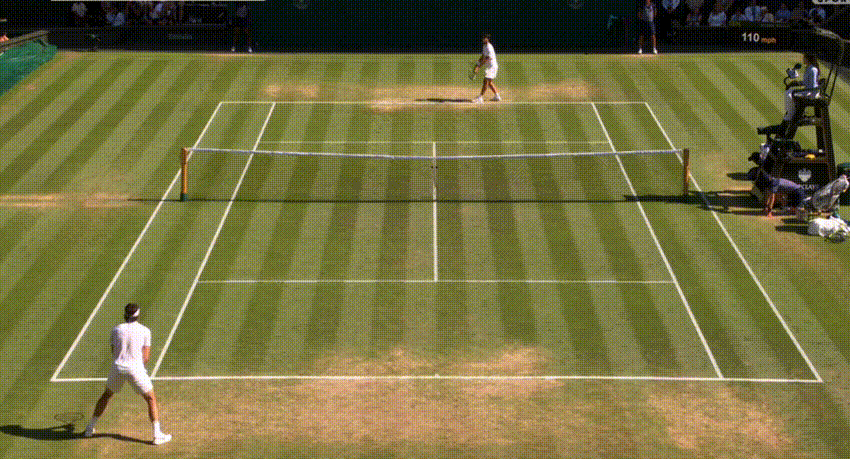
Then there’s the forehand deception and variation he weaves on top of the angles. There’s several trademarks to the Alcaraz game, but his most famous one is the forehand drop shot, which he can also pump fake for a chip.
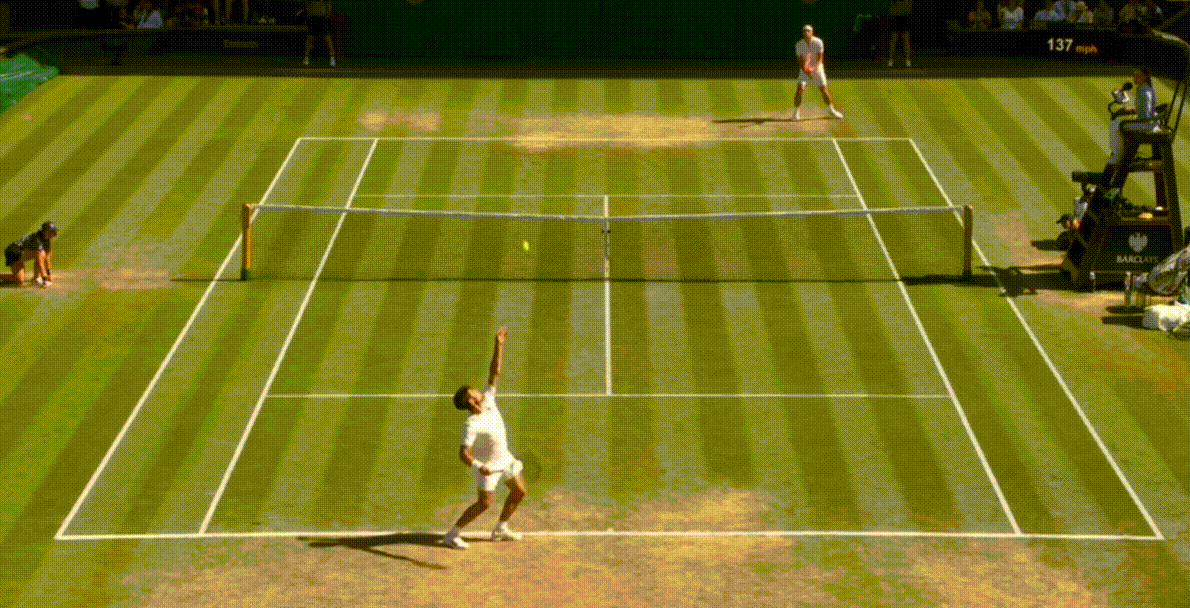
Down the other end, what Sinner lacks in variation he makes up for with consistent speed. It’s the Japanese Bullet Train of forehands, and where I think he is better than anyone right now is when on the dead run, using that cross-over footwork to keep his body quiet as he unloads with flattened counters. Here’s some in both directions from Paris:
As far as baseline rallies go, on the quicker and lower bouncing grass, Sinner will have an easier time keeping this a linear battle compared to Roland Garros, which he did pretty well there anyway. An excerpt:
Sinner took all of Alcaraz’s variation and shoved it back in his face at Mach 5 off both wings for the better part of five hours. That’s why we didn’t see the three-dimensional Jazz festival from Carlos’ end — fewer slices, an unusual number of errant drop shots, flattened trajectories. It’s hard to improvise when you’re getting punched in the face.
I think Sinner has a slight edge in the stock baseline rally off both wings. He is more consistent trading backhands than Alcaraz, and can rush Alcaraz’s forehand more easily. But the Spaniard has a deep bag of tricks to lean on should be find himself getting out-hit. For one, I think we can expect Alcaraz to use the backhand slice to good effect to break the height and rhythm of rallies (Dimitrov, anyone?).
And then there’s everything else besides the rally ball that Alcaraz is a genius at.
In attack, he’s adapted volleying to counter 21st century baseliners, often playing that forehand volley short despite higher and deeper contact points. This is good in theory, but 99.9999% of players will look like an idiot if they try this in practice. He’s going down as one of the greatest volleyers of all-time:
Then there’ that defensive slice I’m always harping on about.1 No one can lay claim to this welded degree of athleticism and mastery. Okay maybe Dan Evans, but he literally built his game around his defensive backhand slice on the grass shores of the grey British Isles. Carlos is a double-handed aggressive baseliner raised on sun-soaked Spanish clay. Make it make sense.
It’s a large reason Alcaraz has been able to get the better of Sinner in their net statistics, and I fully expect that he’ll find ways to get the ball below the net on Sinner tomorrow as well.

It’s going to be a fascinating watch. Alcaraz using angles, crush-and-rush, serve-and-(drop)-volley, defensive slice, and superior movement to checkmate Sinner’s power checks. Sinner will just keep checking harder, bringing linear power, making it as difficult as possible for Alcaraz to do any of that.
We have to talk about serving. For some it’s boring. It’s unsexy. Balance sheet quant chat for New Balance squares. But it’s also the bedrock of a tennis player’s game. It’s hard to serve well and not play well, because plus-one forehands and easy holds and saving break points are so often down-stream of making first-serves. It’s especially important in this rivalry because both men are so good at winning second-serve points. In the last 52 weeks Sinner is the tour leader, winning 56.9% of second-serve return points, with Alcaraz at 53.6%. In recent encounters it has been Sinner who has consistently missed his 52-week average percentage for first-serves (Alcaraz is ~65%, Sinner ~62%). Whether that is variance or Sinner going bigger because of Alcaraz I don’t know, but he needs to hit his number; anything less has fallen short, and it’s an area of the game he has an advantage over Alcaraz (although on grass this year Carlos has been serving great).
Then there’s the mental game. We are only five weeks removed from triple match point in Paris for Sinner. That’s not scar tissue; that’s a seeping wound. How will he handle the occasion if the shores of victory come within sight tomorrow? And yet, does he carry some sort of Lucky Loser mindset in the wake of the Dimitrov match?
For Alcaraz, he owns a commanding lead in the H2H, a win streak dating back to April, two-time defending champion memories, and an ability to work the crowd at pivotal moments with some of the most entertaining tennis we’ve ever seen. Plus, I’ve often wondered if his meandering, set-losing-paths to finals ends up callousing his nerves to such a degree as to render him almost incapable of buckling.
Prediction
Wimbledon has a way of dragging tennis back to more quaint origins — shuffling out of corners, slicing, serve-and-volley, all-white — but it’s still been dominated from the baseline for the last 24 years. It’s a fast court with the same dimensions as any other court.
Given that, I lean towards Jannik Sinner winning.
Here’s a chart of court speed data from 2022, 2023, and 2024from tennisedge.io. I’ve highlighted the matches of Sincaraz with purple (Sinner win), yellow (Alcaraz win), or maroon (one win each) from these years.
We can see that most of their matches have been on the slower side of things. Their 2022 Wimbledon match was the only real ‘fast’ court encounter they played in these years (and Paris in 2021 — won by Alcaraz — was considered a medium court then, unlike the lightning quick court we got in 2024). What’s more, if we take the titles won by Sinner and Alcaraz since the start of 2023, Sinner’s average court speed title is 20.6, whereas Alcaraz’s is 36.7. These aren’t huge differences, but they are differences, and I think over the arc of a career their H2H will reflect this trend: Sinner will have more success on faster surfaces, Alcaraz on slower, bouncier surfaces. We saw this play out very predictably with the Big-3 in terms of their win percentages:

Let’s hope both men bring their best.
I’ll be back with a recap. See you in the comments. HC.
Alcaraz versus: Lehecka in Queens, Sinner in RG, Sinner in Beijing; Medvedev in Indian Wells.
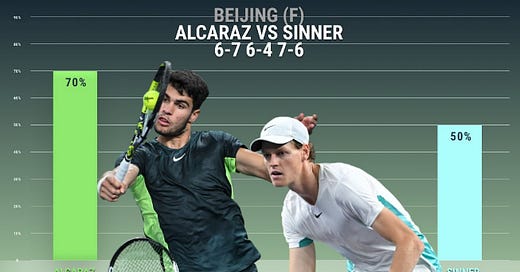







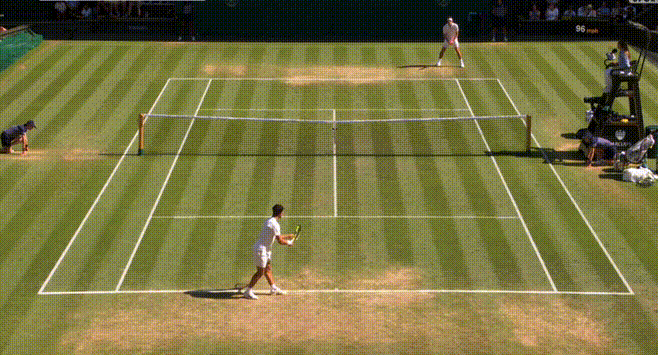
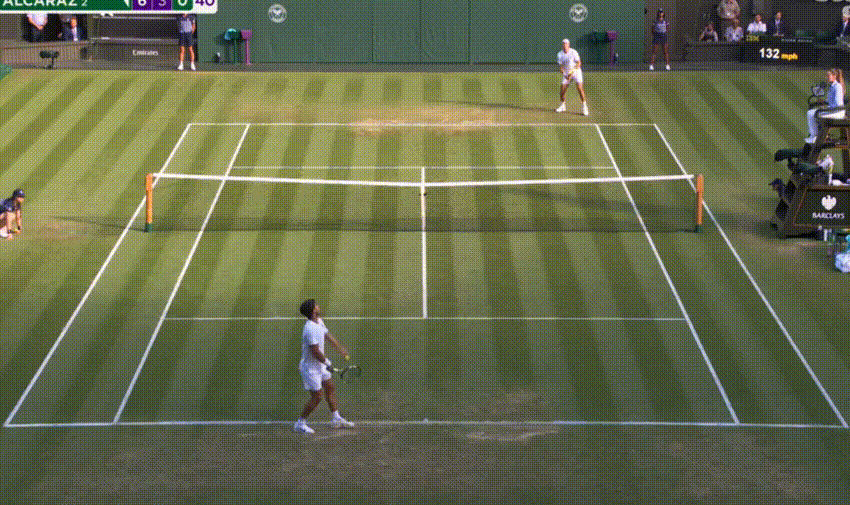



Thanks for the review.
I have been really impressed by Sinner's power against Djokovic, just crushing the ball from whatever position.
I remember a great podcast from Tennis Legend with Adrian Mannarino during 2020 (sadly in French). Manna was saying that he was thinking Djokovic would end his career with a pretty far better record than the other 2 (check).
And the other interesting point was about Sinner : still very rough and far from TOP 5, Mannarino was explaining that what set Sinner apart was his consistent ball striking, i.e : whatever the craftiness with the ball, he could always crush it and overwhelm you.
Sadly I won't be in the stands this time and I won't watch it since I am too partial. It is another 50/50 showdown. I am for Sinner, who remains I believe the underdog, yet, his improvements as a player are so continuous that I feel his everyday avatar is enough against everyone save a "lucky" Alcaraz.
I really wish Sinner to have the good luck on the decisive points, he is already the better player in general.
A preliminary stats analysis confirms the indeniable edge of Sinner this time. One "novelty" : Sinner for the 1st time in 5 matches had a 1st serve % aligned with his average or even slightly better and it helped very much indeed.
Besides that, +11 pts won and a comprehensive domination on all stats : better behind serve and harvesting more points on Alcaraz 2nd serves.
Obviously not a walk in the park but a big enough edge that didn't allow any steal from Alcaraz this time.
Very very impressive, I am also noting that Sinner's 1st serve keeps accelerating, now clocking regurlarly over 210 Km/h (132 mph) : it is something fairly new as well.
His routine level is already incredible by its consistency (I want to draw a parrallele with Martin Fourcade in biathlon) while already executing a the highest level. And yet, he keeps on adding things to his game, like the "hand" crafty shots around the net in which he is not bad at all anymore !